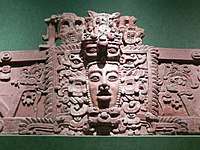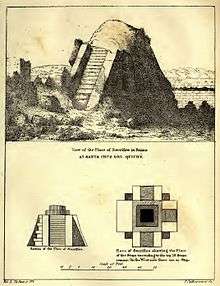Tohil
Tohil (IPA: [toˈχil], also spelled Tojil) was a deity of the Kʼicheʼ Maya in the Late Postclassic period of Mesoamerica.
 |
| Maya civilization |
|---|
| History |
| Preclassic Maya |
| Classic Maya collapse |
| Spanish conquest of the Maya |
At the time of the Spanish Conquest, Tohil was the patron god of the Kʼicheʼ.[1] Tohil's principal function was that of a fire deity and he was also both a sun god and the god of rain.[2] Tohil was also associated with mountains and he was a god of war, sacrifice and sustenance.[3] In the Kʼicheʼ epic Popul Vuh, after the first people were created, they gathered at the mythical Tollan, the Place of the Seven Caves, to receive their language and their gods. The Kʼicheʼ, and others, there received Tohil.[4] Tohil demanded blood sacrifice from the Kʼicheʼ and so they offered their own blood and also that of sacrificed captives taken in battle. In the Popul Vuh this consumption of blood by Tohil is likened to the suckling of an infant by its mother.[5]
Tohil may originally have been the same god as Qʼuqʼumatz, and shared the attributes of the feathered serpent with that deity,[6] but they later diverged and each deity came to have a separate priesthood.[7] Sculptures of a human face emerging between the jaws of a serpent were common from the end of the Classic Period through to the Late Postclassic and may represent Qʼuqʼumatz in the act of carrying Hunahpu, the youthful avatar of the sun god Tohil, across the sky.[8] The god's association with human sacrifice meant that Tohil was one of the first deities that the Spanish clergy tried to eradicate after the conquest of Guatemala.[9]
Attributes
There is disagreement over the meaning of the name of the deity. It has been interpreted as meaning "obsidian",[10] as deriving from the word toh ("rain")[11] and as meaning "tribute" or "payment".[12] Tohil was one of a trinity of gods worshipped by the Kʼicheʼ elite, together with Awilix and Jacawitz. The concept of a triad of deities was ancient in Maya religion, dating as far back as the Late Preclassic.[13] The triad of Kʼicheʼ gods were sometimes referred to collectively as Tohil.[14] Tohil has been equated with the Classic Period God K.[15] The deity also possesses attributes that suggest a link with Mixcoatl, a hunting god of the Aztecs.[16]
Tohil was the patron deity of the Kaweq lineage of the Kʼicheʼ.[17] He was associated with a sacred deerskin bundle that was said to embody him, and one of his titles was Qajawal Kej ("Our Lord Deer").[18] The deity was associated with thunder, lightning and the sunrise.[19]
Worship
The Kaweq lineage of the Kʼicheʼ built a temple to Tohil at their first capital Jacawitz, identified as the archaeological site of Chitinamit. Jacawitz was overlooked by a shrine to the god placed on a neighbouring peak, this shrine was known as Pa Tohil.[21] Later the Kʼicheʼ built their main temple to Tohil at Qʼumarkaj, their new capital. They made him offerings on the day Toh, one of the days of their 20-day calendar cycle.[22] The Kʼicheʼ performed the Great Dance of Tohil in honour of the deity in the month of Tzʼikin Qʼij, prior to the maize harvest (which takes place in November).[23] This dance took place at Qʼumarkaj and involved a gathering of all the principal lineages subject to the Kʼicheʼ Kingdom of Qʼumarkaj, and as is described in the Kʼicheʼ chronicle Título de Totonicapán,[24] they were expected to bring tribute, slaves and sacrifices.[25]
The priests of Tohil were known as Aj Tohil and were selected from the ruling Kaweq lineage of Qʼumarkaj. During their ceremonies to Tohil, the Kʼicheʼ would offer quetzal feathers to the god.[26] Writing at the end of the 17th century, Francisco Ximénez described the tradition that upon the temple human sacrifices were tied before the representation of Tohil, where the priest would open the victim's chest and cut out his heart.[27] After sacrifice, the victim's body was probably hurled down the front stairway of the temple where his head would be severed to be placed on a skull rack that was located in front of the temple.[28]
Equivalents to Tohil were worshipped by other groups closely related to the Kʼicheʼ. These included Belehe Toh of the Kaqchikels and Hun Toh of the Rabinal,[29] this last name meaning "One Rain", a calendrical date.[30] The Kaqchikel and the Rabinal did not merely think their own patrons were equivalent to Tohil, they claimed that they were the same deity under a different name.[31] The Kʼicheʼ themselves claimed in the Popul Vuh that their patron Tohil was the same as Quetzalcoatl of the Aztecs.[32]
Temple of Tohil
The Temple of Tohil at Qʼumarkaj was the tallest structure in the city. The rubble core of the building still stands but the stone facing has been looted. The temple was originally a pyramid with stairways on all four sides, the summit shrine faced towards the rising sun in the east. This form of radial pyramid temple was built by the Maya since the Late Preclassic with examples at many archaeological sites such as Tikal, Copán and Chichen Itza, among others. According to John Lloyd Stephens, who visited the site in the 1830s, the temple base measured 66 feet (20 m) square and it stood 33 feet (10 m) high. At that time the radial stairways were more-or-less intact. The temple was originally covered in painted stucco, with the decoration including the painted image of a jaguar.[33]
Modern worship
Deerskins, the symbol of Tohil, are to this day venerated in many highland Maya communities and are used in dances.[34] In the modern village of Santiago Atitlán in the Guatemalan highlands, a traditional Maya priesthood performs rites to a powerful deity addressed as "King Martin, Lord of the Three Levels, Lord of Rain, Lord of Maize, and Lord of all the Mountains".[35] This priest blesses deerskins prior them being worn, with head and antlers attached, during the Dance of Martin on November 11 prior to the maize harvest. King Martin is probably a blend of Tohil and his deerskin bundle with the Roman Catholic St Martin of Tours, whose feast falls on the same day.[36] In Rabinal, Tohil was merged with St Paul while still retaining many of his characteristics.[37]
See also
Notes
- Miller & Taube 1993, 2003, p.170.
- Christenson 2003, 2007, p.79.n.152. Sharer & Traxler 2006, p.718. Orellana 1981, p.160.
- Carmack 2001a, p.358. Carmack 2001b, p.124. Sachse & Christenson 2005, p.15.
- Read & González 2000, p.90.
- Miller & Taube 1993, 2003, p.170.
- Fox 1987, 2008, p.60.
- Orellana 1981, p.159.
- Fox 1987, 2008, pp.60, 249.
- Orellana 1981, p.173.
- Miller & Taube 1993, 2003, p.170.
- Recinos et al 1954, p.132.
- Sachse & Christenson 2005, p.15.n.11.
- Christenson 2003, 2007, p.61.n.65.
- Christenson 2003, 2007, p.228.n.646.
- Miller & Taube 1993, 2003, p.170.
- Van Akkeren 1999, p.285.
- Sharer & Traxler 2006, p.718.
- Christenson 2003, 2007, pp.220, 239.n.680. Sachse & Christenson 2005, p.15.
- Fox 1989, p.660.
- Miller & Taube 1993, 2003, p.170.
- Fox 1989, pp.663-664.
- Miller & Taube 1993, 2003, p.170.
- Christenson 2003, 2007, p.220.n.620.
- Christenson 2003, 2007, p.260.n.775.
- Orellana 1981, p.160.
- Orellana 1981, pp.162-163.
- Carmack 2001a, pp.356-357.
- Carmack 2001a, p.360.
- Recinos 1998, p.46.
- Recinos et al 1954, p.132.
- Fox 1989, p.665.
- Christenson 2003, 2007, pp.19, 217.
- Christenson 2003, 2007, pp.268-269.n.821.
- Christenson 2003, 2007, p.244.n.698.
- Christenson 2003, 2007, p.220.n.620.
- Christenson 2003, 2007, p.220.n.620.
- Van Akkeren 1999, p.288.
References
- Carmack, Robert M. (2001a). Kikʼulmatajem le Kʼicheʼaabʼ: Evolución del Reino Kʼicheʼ (in Spanish). Guatemala: Iximulew. ISBN 99922-56-22-2. OCLC 253481949.
- Carmack, Robert M. (2001b). Kikʼaslemaal le Kʼicheʼaabʼ: Historia Social de los Kʼicheʼs (in Spanish). Guatemala: Iximulew. ISBN 99922-56-19-2. OCLC 47220876.
- Christenson, Allen J. (2007) [2003]. "Popul Vuh: Sacred Book of the Quiché Maya People" (PDF online publication). Mesoweb articles. Mesoweb: An Exploration of Mesoamerican Cultures. Retrieved 2010-01-23.
- Fox, John W. (2008) [1987]. Maya Postclassic state formation. Cambridge, UK and New York, USA: Cambridge University Press. ISBN 978-0-521-10195-0. OCLC 297146853.
- Fox, John W. (September 1989). "On the Rise and Fall of Tuláns and Maya Segmentary States". American Anthropologist. New Series. Oxford, UK and Arlington, Virginia: Blackwell Publishing on behalf of the American Anthropological Association. 91 (3): 656–681. doi:10.1525/aa.1989.91.3.02a00080.
- Miller, Mary; Karl Taube (2003) [1993]. An Illustrated Dictionary of the Gods and Symbols of Ancient Mexico and the Maya. London: Thames & Hudson. ISBN 0-500-27928-4. OCLC 28801551.
- Orellana, Sandra L. (Spring 1981). "Idols and Idolatry in Highland Guatemala". Ethnohistory. Duke University Press. 28 (2): 157–177. doi:10.2307/481116.
- Read, Kay Almere; Jason González (2000). Handbook of Mesoamerican Mythology. Oxford: ABC-CLIO. ISBN 1-85109-340-0. OCLC 43879188.
- Recinos, Adrian (1998). Memorial de Solalá, Anales de los Kaqchikeles; Título de los Señores de Totonicapán (in Spanish). Guatemala: Piedra Santa. ISBN 84-8377-006-7. OCLC 25476196.
- Recinos, Adrian; Delia Goetz; Sylvanus Griswold Morley (1954). "Popul Vuh, the Book of the People". Los Angeles, USA: Plantin Press. Archived from the original (PDF) on 2009-02-14. Retrieved 2010-01-24.
- Sachse, Frauke; Allen J. Christenson (2005). "Tulan and the Other Side of the Sea: Unraveling a Metaphorical Concept from Colonial Guatemalan Highland Sources" (PDF online publication). Mesoweb articles. Mesoweb: An Exploration of Mesoamerican Cultures. Retrieved 2010-01-24.
- Sharer, Robert J.; Loa p. Traxler (2006). The Ancient Maya (6th (fully revised) ed.). Stanford, CA: Stanford University Press. ISBN 0-8047-4817-9. OCLC 57577446.
- van Akkeren, Ruud (1999). "Sacrifice at the Maize Tree: Rabʼinal Achi in its historical and symbolic context". Ancient Mesoamerica. Cambridge University Press. 10: 281–295. doi:10.1017/s0956536199102104.

